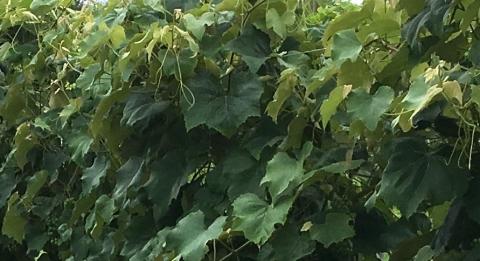Fruitless wild grapevines

While wild grapevines are pervasive throughout New England, they often go unnoticed through much of the year even as they climb over stone walls and up into tree canopies. That is, until the week they ripen in the fall, when the powerful scent of grapes fills the air, attracting jelly enthusiasts far and wide.
I was recently asked by a gardener why a grapevine growing on his property never produced any fruit, despite excellent growth in a sunny location. I, too, have observed a wild grapevine near my property that grows profusely each season, covering our stone wall, and yet, despite the excellent crop on my cultivated grapes, I have yet to see a fruit on this vine. Why is this?
The answer is an interesting one. The most common “wild” grapes in New England are Vitis labrusca (fox grape) or Vitis riparia (riverbank grape, or frost grape) – both of which are what is called dioecious, which means that they have separate male and female plants. In contrast, most cultivated grape varieties are hermaphroditic, meaning that their flowers have both male and female parts – which is convenient because those vines will self-pollinate, producing fruit without a “mate” nearby.
Back to my very vigorous but unproductive grapevine. Sure enough, when I examined the flowers at bloom time (mid June) last year, I discovered that he was a male. You can see this in the photos below.
On the first photo, the arrow is pointing out a “perfect” flower, which has both a well-developed ovary, which will become a grape once pollinated, and five stamens, which bear the pollen that will pollinate the flower. On the second photo, the arrow is pointing to a yellow-colored undeveloped ovary that is non-functional. Note that all of the flowers have plenty of stamens, but there are no normal ovaries that can develop into fruits.

is pointing out a well-developed ovary that will produce a grape if fertilized.

an unedeveloped ovary that cannot be fertilized.
The first photo is a photo of one of my cultivated (hermaphroditic) grapevines, and the second photo is from my neighbor’s very robust male grapevine. Alas, I had solved the mystery – but what a disappointment to realize that such a beautiful vine will never produce fruit. If you have such a vine, it’s relatively easy (at bloom time) to figure out whether you have a male, a female, or a hermaphroditic plant – just by looking.
A bonus observation: it wasn’t until I was editing the photographs that I noticed an additional creature (Alan says it is a tarnished plant bug relative) in one of the pictures. Can you see it?
